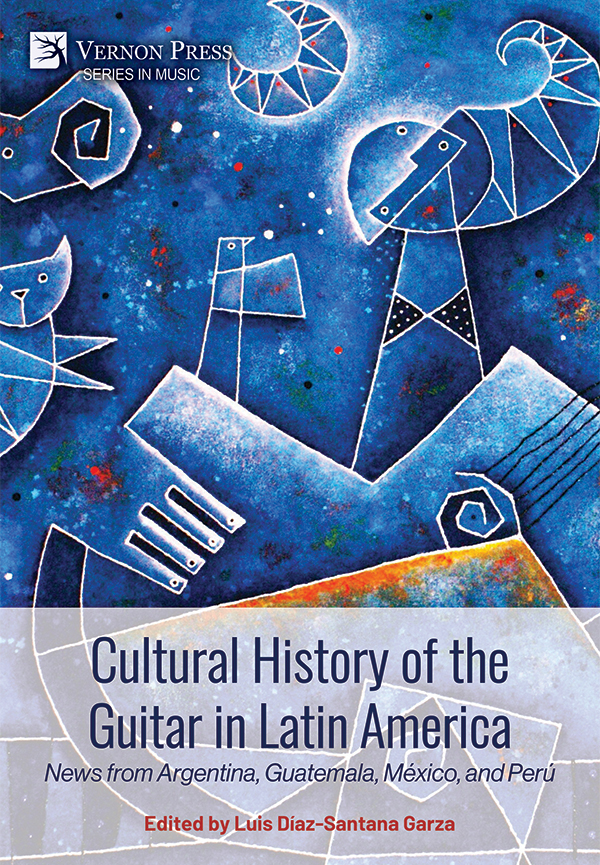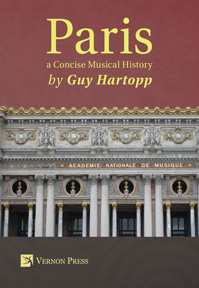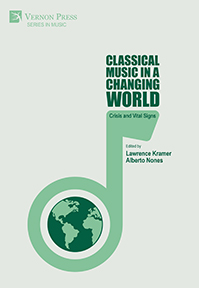Cultural History of the Guitar in Latin America: News from Argentina, Guatemala, México, and Perú
Luis Diaz Santana Garza (Ed.)
by Alejandro Vera (Pontificia Universidad Católica de Chile, Chile), Juan Frajoza (University of Guadalajara, Mexico), Juan Pablo Pira Martínez (Asociación de Investigación y Estudios Sociales, Guatemala), Sonia Medrano Ruiz (Universidad Autónoma de Zacatecas, Mexico), Arturo Javier Ramírez Estrada (Autonomous University of Nayarit, Mexico), Ericka Beatriz Morales Trejo (Autonomous University of Nayarit, Mexico), Alejandro Martínez de la Rosa (Universidad de Guanajuato, Mexico), Eric Johns (Tulane University), Enrique Salmerón (Universidad Veracruzana, Mexico)
Purchase this book
(click here to change currency)
The objective of this book is to disseminate the rich history of the guitar in Latin America, with special emphasis on Mexico, covering a period that goes from the viceregal age to the present day. The collaborators are some of the most outstanding guitarists and researchers of the instrument from Chile, Mexico, Guatemala and the United States. The chapters aim to explore the composers, performers, repertoire and construction of the guitar since the sixteenth century in Latin America and the US, but also to comprehend the social role and economic ecosystem of the instrument. Due to the long chronology proposed, the book not only deals with the modern guitar, but also with the baroque guitar, and there is even a chapter dedicated to the traditional instruments that have historically been heirs to the Spanish guitar. The originality of this work resides in the use of historical and humanistic tools. It is based on a current bibliography, and it is one of the first books published in English on the history of the guitar in Latin America.
List of Figures and Images
List of Tables and Map
Preface
Part I: Guitar in History
Chapter 1
The Guitar in the Viceroyalty of Peru
Alejandro Vera
Pontificia Universidad Católica de Chile, Chile
Chapter 2
Diego Risueño, a Peninsular Musician Before the Novohispanic Inquisition (1580-1602)
Juan Frajoza
Universidad de Guadalajara, México
Chapter 3
Scale Exercises for Five-Course Guitar from a Late Guatemalan Manuscript
Juan Pablo Pira Martínez
Asociación de Investigación y Estudios Sociales, Guatemala
Chapter 4
Perceptions of the Guitar in Mexican Periodicals, Poems and Chronicles: From the End of Viceroyalty to the Nineteenth Century
Luis Díaz-Santana Garza
Universidad Autónoma de Zacatecas, México
Chapter 5
Builders and Importers of Guitars in México and the United States During the Nineteenth and Twentieth Centuries
Sonia Medrano Ruiz
Universidad Autónoma de Zacatecas, México
Luis Díaz-Santana Garza
Universidad Autónoma de Zacatecas, México
Part II: Guitar in Popular Music
Chapter 6
Más Allá de la Guardia Vieja: Tango Guitar in the Long Nineteenth Century
Eric Johns
Tulane University
Chapter 7
“Sin guitarra no hay canción:” Mexican Rural Culture in Canción Ranchera
Arturo Javier Ramírez Estrada
Universidad Autónoma de Nayarit, México
Ericka Beatriz Morales Trejo
Universidad Autónoma de Nayarit, México
Luis Díaz-Santana Garza
Universidad Autónoma de Zacatecas, México
Chapter 8
Two Jarana Models from Western and Southern México: Tierra Caliente and Mixteca, Twentieth Century
Alejandro Martínez de la Rosa
Universidad de Guanajuato, México
Part III: The Classical Guitar
Chapter 9
“If the Guitar Hadn’t Existed, I Would Have Invented It:” Andrés Segovia and His Debut in México in 1923
Luis Díaz-Santana Garza
Universidad Autónoma de Zacatecas, México
Chapter 10
The Hidden Repertoire of the Mexican Guitar, 1923–1960
Enrique Salmerón
Universidad Veracruzana, México
About the Contributors
Notes
Index
Luis Díaz-Santana Garza studied a Bachelor of Music, a Master of Arts, and a PhD in History. He has conducted research on music from the Baroque period to the present, performing with original instruments such as the baroque guitar and the 19th-century Mexican seven-string guitar. A member of the National Research System, he is a full-time professor of guitar, baroque music, and Mexican music history at the Arts Department of Zacatecas Autonomous University. He has received several fellowships from CONACYT, CONACULTA, INBA, and PACMYC. His recordings include Mexican songs and dances of the 19th century, the opera San Francisco Xavier, and two records of Mexican music for guitar from the 19th century. He has published articles in ‘Acta Musicologica, Diagonal’, and ‘Boletin Música of Casa de las Américas’, and wrote the books ‘Music Tradition in Zacatecas (1850–1930)’, ‘Transcription of Baroque Guitar Music’, ‘History of Mexican Norteño Music’, ‘A Dictionary of Popular Music’, and ‘Between Norteño and Tejano Conjunto: Music, Tradition, and Culture at the U.S.-Mexico Border’ (Lexington Books, 2021).
Guitar, Viceroyalty of Perú, Music and Society, Vihuela, New Spain, Diego Risueño, Baroque music, Guatemala, Music manuscript, Mexican periodicals, Cultural studies, Economy, Builders and importers, Tango, Argentina, Mexican guitar, Popular music, Canción ranchera, Jarana, Mexican popular music, Popular culture, Andrés Segovia, Self-Fulfilling Prophecy, Matthew Effect, Music repertoire, Mexican composers
Subjects
Sociology
History
Music Studies
Series
Series in Music
Related services
Download print-friendly flyer Download sample chapter Download HQ coverSee also
Bibliographic Information
Book Title
Cultural History of the Guitar in Latin America: News from Argentina, Guatemala, México, and Perú
ISBN
979-8-8819-0154-7
Edition
1st
Number of pages
214
Physical size
236mmx160mm







